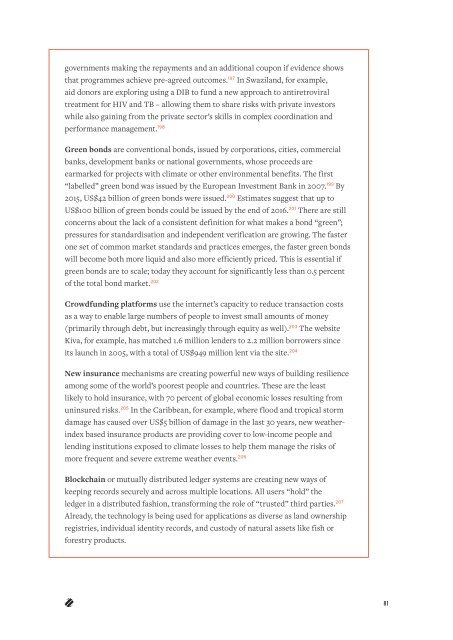BETTER BUSINESS BETTER WORLD
2jxE7K2
2jxE7K2
You also want an ePaper? Increase the reach of your titles
YUMPU automatically turns print PDFs into web optimized ePapers that Google loves.
governments making the repayments and an additional coupon if evidence shows<br />
that programmes achieve pre-agreed outcomes. 197 In Swaziland, for example,<br />
aid donors are exploring using a DIB to fund a new approach to antiretroviral<br />
treatment for HIV and TB – allowing them to share risks with private investors<br />
while also gaining from the private sector’s skills in complex coordination and<br />
performance management. 198<br />
Green bonds are conventional bonds, issued by corporations, cities, commercial<br />
banks, development banks or national governments, whose proceeds are<br />
earmarked for projects with climate or other environmental benefits. The first<br />
“labelled” green bond was issued by the European Investment Bank in 2007. 199 By<br />
2015, US$42 billion of green bonds were issued. 200 Estimates suggest that up to<br />
US$100 billion of green bonds could be issued by the end of 2016. 201 There are still<br />
concerns about the lack of a consistent definition for what makes a bond “green”;<br />
pressures for standardisation and independent verification are growing. The faster<br />
one set of common market standards and practices emerges, the faster green bonds<br />
will become both more liquid and also more efficiently priced. This is essential if<br />
green bonds are to scale; today they account for significantly less than 0.5 percent<br />
of the total bond market. 202<br />
Crowdfunding platforms use the internet’s capacity to reduce transaction costs<br />
as a way to enable large numbers of people to invest small amounts of money<br />
(primarily through debt, but increasingly through equity as well). 203 The website<br />
Kiva, for example, has matched 1.6 million lenders to 2.2 million borrowers since<br />
its launch in 2005, with a total of US$949 million lent via the site. 204<br />
New insurance mechanisms are creating powerful new ways of building resilience<br />
among some of the world’s poorest people and countries. These are the least<br />
likely to hold insurance, with 70 percent of global economic losses resulting from<br />
uninsured risks. 205 In the Caribbean, for example, where flood and tropical storm<br />
damage has caused over US$5 billion of damage in the last 30 years, new weatherindex<br />
based insurance products are providing cover to low-income people and<br />
lending institutions exposed to climate losses to help them manage the risks of<br />
more frequent and severe extreme weather events. 206<br />
Blockchain or mutually distributed ledger systems are creating new ways of<br />
keeping records securely and across multiple locations. All users “hold” the<br />
ledger in a distributed fashion, transforming the role of “trusted” third parties. 207<br />
Already, the technology is being used for applications as diverse as land ownership<br />
registries, individual identity records, and custody of natural assets like fish or<br />
forestry products.<br />
81


